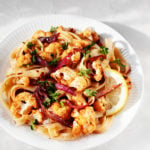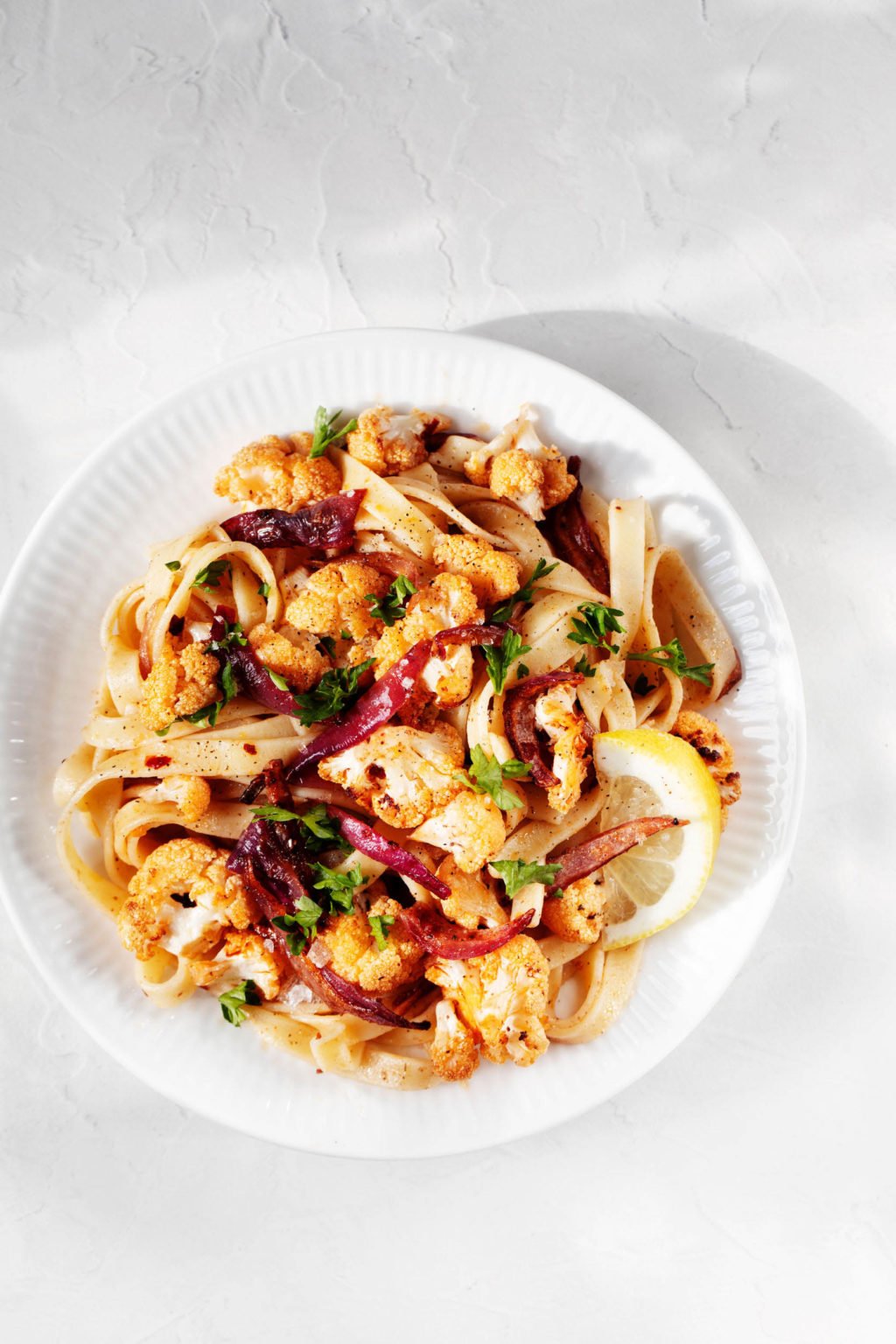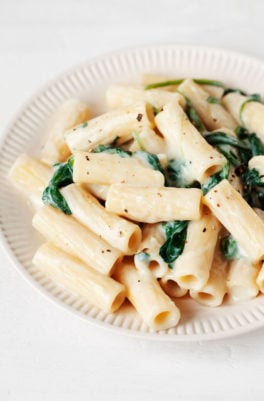This vegan roasted cauliflower pasta is satisfying and easy to prepare. Roasted cauliflower and red onion gives the pasta depth of savory flavor, while lemon juice and zest keep it bright. This is a perfect weeknight pasta supper at any time of year!

I could easily eat pasta every night of the week. It’s fast, comforting, endlessly versatile, and an easy vehicle for vegetables and beans.
When I’m in a food rut, I start to default to marinara sauce on pasta more often than not. And while I’m always pretty happy to eat a plate of spaghetti and marinara, it’s good to keep things varied. Especially if variety means incorporating more vegetables into my pasta suppers.
This vegan roasted cauliflower pasta is such a nice addition to my pasta rotation. It’s got cauliflower and red onion for vegetable goodness, and they’re both roasted to deepen and bring out their flavor. The dish also has a little spice from crushed red pepper and brightness from lemon. So much to love here!
How to make roasted cauliflower pasta
Like most of my favorite pasta suppers, this one is pretty easy to prepare. Roasting adds a little time to the recipe as a whole, but it’s also hands-off work. While the cauliflower and red onion roast, which is the first preparation step, you can prepare everything else that you’ll need for the pasta.
Prep your vegetables
For this dish, I like to slice the red onion into half moons. You can break the cauliflower down however you normally like to; this tutorial is one of my favorites for cutting and coring cauliflower.
Roast the vegetables
The cauliflower and onion will need about 25 minutes in a 400 °F oven. The cauliflower is done when the edges are crisping and the florets and pieces are all fork tender.
Boil pasta water
While the vegetables roast, you’ll boil you pasta water. It should be well salted—not necessarily like the sea, but if you were to taste the water, you’d want to taste the salt.
Cook your pasta al dente according to package instructions.
Heat garlic
Some of the oil in this recipe is used for roasting the cauliflower. The rest is used to quickly heat some minced garlic in a large, covered casserole or deep skillet. To the garlic, you’ll add your cooked pasta, roasted vegetables, lemon juice and zest, and some cooking water to help loosen the pasta and bring the dish together.
Season to taste
For simple pasta suppers such as this one, I find that it’s always important to taste and season as you go. Once you’ve mixed all of the pasta ingredients together in your casserole or large skillet, be sure to taste the pasta. Add salt, additional red pepper flakes, and lemon as needed.
I also like adding my cashew parmesan cheese to the pasta when I plate it. Here, too, you can use your intuition and season to taste!

Roasted cauliflower pasta ingredients
You won’t need too many ingredients to bring this vibrant pasta to life. Here’s what you will need:
Cauliflower
You’ll need a medium sized head of cauliflower to prepare the roasted cauliflower pasta. Mine was about a pound and a half, but a little less or more will be fine.
If you can’t get your hands on cauliflower that’s fresh, a pound of frozen and thawed cauliflower florets will work for roasting.
Red onion
I love the sweetness of roasted red onion in this recipe, but you can use white or yellow onion if you don’t have red at home.
Paprika
Seasonings in this recipe are spare, but I love the hint of paprika on the cauliflower, as well as the color that it contributes!
Crushed red pepper
Crushed red pepper, which is also sometimes labeled “red pepper flakes,” is what gives the roasted cauliflower pasta its hint of spicy heat.
Lemon
Don’t skip the lemon juice and zest in the recipe! Their brightness and zestiness is an important counterbalance to the earthiness of the roasted vegetables.
Garlic
I use three cloves of garlic for the recipe. If you’re a garlic lover, feel free to add more.
Parsley
As with the lemon, parsley contributes freshness and brightness to the finished pasta.
Pasta
I’ve made the roasted cauliflower pasta with a number of pasta shapes. They include long shapes, like fettuccine (pictured here) and spaghetti. I’ve also made it with medium pasta shapes: my favorites are penne, fusilli, and casarecce.
You can also make the pasta with a shorter shape, such as orecchiette or lumache.
Bottom line? Use the pasta you love. It can be a short or long shape, regular pasta or a gluten free or bean-based option (such as chickpea pasta). Be sure to cook the pasta al dente, according to package instructions.
Cashew parmesan cheese
A generous dusting of my cashew parmesan cheese certainly isn’t necessary, but it does elevate the finished dish! I’ll eat cashew parm on just about anything, so I’m always game for using it as a finishing touch.
Preparation and storage
I tend to think that this roasted cauliflower pasta tastes best when it is freshly made.
However, you do have some make-ahead options. If you roast the cauliflower and red onion ahead of time, that will make preparing the pasta very fast. The roasted vegetables will keep in an airtight container in the fridge for up to 4 days.
Store leftovers of the finished pasta dish in an airtight container in the fridge for up to 3 days. I don’t recommend this one for freezing.

More simple pasta meals
Nothing like a low-key pasta supper, right? Here are some of my other favorites, for all of the seasons:
- Simple burst cherry tomato pasta
- Tex Mex skillet pasta
- Lentil tomato pasta stew
- Creamy beet kale fusilli
- Curried tahini pasta salad
- Balsamic roasted vegetable pasta
- Zucchini corn pasta
- Easy, vegan and gluten free mac n’ cheese with peas
- Pasta alla vecchia bettola (pasta alla vodka)
- Caramelized cabbage and onion pasta
- Pasta alla Norma

Spicy Roasted Cauliflower Pasta with Lemon
Author –Ingredients
- 1 medium head cauliflower, thick stem removed and cut into bite-sized florets and pieces (about 1 1/2 pounds before preparation)
- 1 large red onion, halved lengthwise and then sliced crosswise into ½-inch half moons
- 3 tablespoons olive oil (divided)
- kosher salt
- 1 1/2 teaspoons paprika
- 1 teaspoon crushed red pepper flakes (or to taste)
- 12 ounces pasta of choice
- 2 cloves garlic, minced
- 2 tablespoons freshly squeezed lemon juice
- 1 tablespoon lemon zest
- 1/4 cup chopped parsley leaves
- cashew parmesan cheese
Instructions
- Preheat the oven to 400F. Toss the cauliflower, red onion, salt, paprika, and crushed red pepper in 1 1/2 tablespoons of the oil. Transfer the vegetables to a baking sheet lined with parchment paper or foil. The florets should be in a single layer and now crowded; if you need to use two sheets to achieve this, that's fine. Roast for 25 minutes, or until the cauliflower is tender and crispy on the edges, stirring once halfway through.
- While the vegetables roast, bring a large pot of salted water to boil. Add the pasta. Cook according to package instructions, stirring frequently, until the pasta is done. Drain, reserving 3/4 cup cooking water.
- Heat the remaining 1 1/2 tablespoons of oil over low heat in a large sauté pan. Add the garlic and cook, stirring constantly, for 20-30 seconds, until the garlic is fragrant. Add the pasta, the lemon juice and zest, the parsley, the roasted cauliflower, and a half cup of pasta cooking water. Stir everything together and heat through. If the pasta feels too thick or is sticking together at all, stir in a splash of the cooking water and/or olive oil. Taste and add additional salt, crushed red pepper, and lemon as needed. Serve right away, with cashew parmesan cheese to taste.

While I tend to make this pasta most often in the wintertime, it’s really a good one for any time of year. I hope you’ll enjoy it, too!
xo
This post may contain affiliate links. If you use these links to buy something I may earn a commission. Visit my privacy policy to learn more.
Method: Oven, Stovetop
Ingredients: Cauliflower
Dietary Preferences: Gluten Free, Soy Free, Tree Nut Free, Vegan





Leave a Comment
I tried this today, with simple olive oil, juice of a whole lemon and without parsley (did not have any at hand). Served it with wholegrain pasta – delicious! Thanks for the simple yet yummy recipe.
I’m so happy the recipe was a success, Britta!
Do you know if Thrive’s algae oil is a source of EPA/DHA or is it somehow refined out?
Not a high source, from what I can tell, which I think is the oil’s only real disadvantage. Like olive, canola, and other vegetable oils, it’s the MUFAs and PUFAs that are the selling point — but I, too, wish there were a higher DHA/EPA content! Thank goodness for flax oil…
I’d love to see this high-heat oil crisp up some sweet potato fries!
I have been wanting to try algae oil since i first read about it. Sadly I don’ thave any local stores that sell it yet.
This recipe sounds amazing… I love heat and quick dishes. I would use the algae oil for this dish
Roasted cauliflower has been my latest obsession. It tastes so amazing!
This looks great!
i would love to use it for roasting a big pan of root vegetables!
I would like to try roasting vegetables with this oil! What does it taste like?
Very neutral, Melissa — I’d compare it to canola or grapeseed oil in terms of taste.
I made this recipe last night- pretty good! I felt like it needed a little extra something- will experiment more next time
baked chicken
This pasta dish looks so good. I can’t believe you don’t make pasta when you are in a hurry. It’s so easy to make and you can add so many veggies to the pasta 🙂 Anyways, I am looking forward trying this pasta. Happy weekend!
I’d love to try the oil for baking sweet potato wedges, or even kale chips!
I’d love to try it in a stir fry!
So great to see this today! I was actually just googling the other day to find a good high heat cooking oil, thanks so so much for the tip!
I would probably give the oil to my mom. She usually uses olive oil to stir fry veggies with her dinners. Maybe she would like this oil too.
I’d try it with anything, especially fried or roasted vegetables.
I would love to try roasting vegetables with the oil!
I’d like to try thrive oil on crispy roasted potatoes! Or really roasted anything 🙂
This sounds absolutely delicious, and handy, too, since one of my new year’s resolutions is to eat more cauliflower, just because I like it so much! I am intrigued by this oil, especially since Dr. Ornish sit on the board of the company. (I never know if I do the submit things right for the giveaways, but if I did, count me in. 🙂 xo
At the end of step 2…”reserving 1/2 cup of the cooking water” but you don’t mention in step 3 what to do with it.
Deb, thanks so much for catching. I reserve the water in case any of the pasta starts to stick together or feel heavy at the end of the recipe — so, it’s something you add a splash of as needed. I edited the instructions to reflect!
roasted veggies with some herbs. yummmmy
I’d love to try this with other roasted vegetables, like butternut squash and Brussels sprouts. And I’d be curious to see what it is like in baked goods as well!
I could see this oil being great for baking if it’s really neutral! And the high smoke point would make it good for grilling/ roasting! I’m definitely going to have to check it out!
Roasted sweet potato fries would be delicious with the algae oil!
I think Thrive oil would be really great for cooking any vegetable that’s getting a flavorful sauce on it–I always feel like bad using oilve oil in those cases. Especially for pan frying marinated tofu!
I would like to roast cauliflower with this oil. I love roasted veggies!